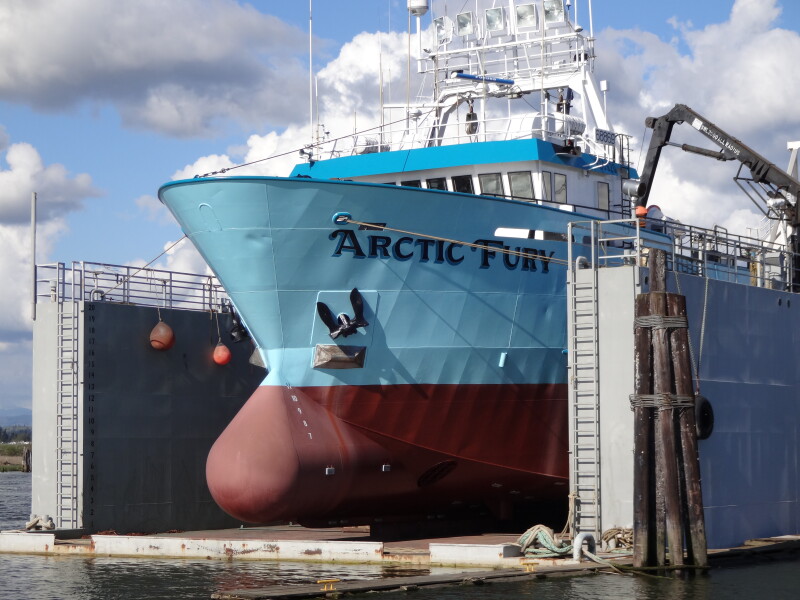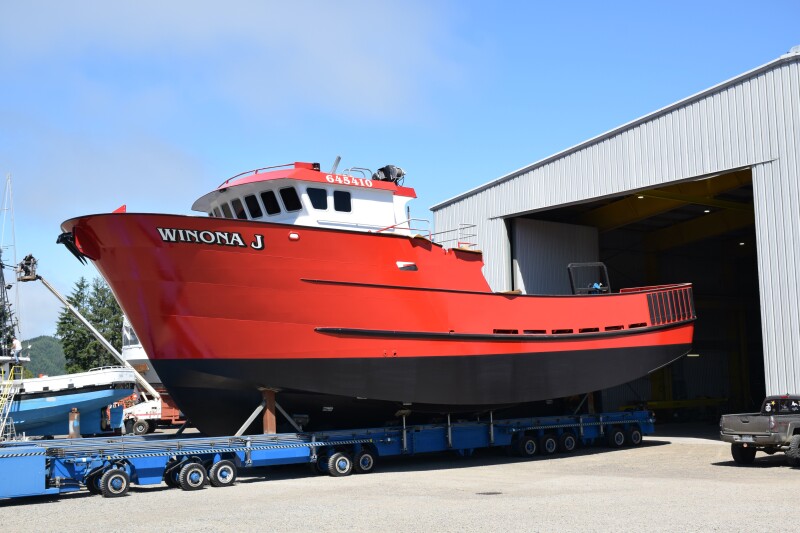The Winona J arrived at Fred Wahl Marine Construction in Reedsport, Ore., measuring 68' x 22'. The West Coast crabber and shrimper left at the end of June, after being sponsoned and lengthened to 70' x 31' 8". And whereas she could only use the front fish hold before, “now it can use both tanks and still have crab pots onboard,” says Fred Wahl Marine’s Mike Wahl.
A much more extensive rebuilding job involved the 98' x 32' Bering Sea crabber Keta that was hauled out at Fred Wahl Marine Construction for seven months. It didn’t take long before that length measurement changed, starting with cutting off the hull aft of the engine room bulkhead and discarding it.
Its replacement stretches back 83 feet, giving the Keta an overall length of 123 feet. While the new stern section was being built, the engine room was gutted out, rewired, and given new generators and a new 1,100-hp Mitsubishi main engine. The Keta’s additional length increased its fish hold and fuel carrying capacities. (See the feature story on page 26.)
After the Keta left on sea trials at the end of July, work continued on a 58' x 30' spec boat. It should be completed by mid-August when the Alaska Trojan, which fishes out of Dutch Harbor, is due in to be sponsoned from 130' x 30' to 130' x 41'. The additional beam will give her “more pot carrying capacity and allow her to fish in harder weather,” says Wahl.
Smaller projects included the 68' x 24' Noyo Dawn, a shrimper and crabber out of California that was hauled for some work on her prop and a paint job. Another short-term project was the 72-foot shrimper and crabber Excalibur that received a paint job and a new Nautican system. Instead of buying a new engine, “he’s trying to gain as much efficiency as he can out of the (existing) engine,” says Wahl.
Expanding its appeal to owners of larger vessels, Fred Wahl Marine Construction, which currently has a 685-ton travel lift, will have a new 820-ton travel lift in operation this fall.

Hansen Boat Co. in Everett, Wash., had a couple of boats in from Seattle’s Fury Group for dry-docking and repairs. They were the Arctic Fury, a 135-foot pollock, hake and whiting dragger, and the 125-foot Ocean Fury, a crabber and salmon tender.
The Arctic Fury had corrosion issues at the ends of its two generators. They needed to be removed from the boat but couldn’t be taken out through the interior passageway. So a hole was cut in the deck, and the two generator ends were pulled up through the opening, rebuilt and then reinstalled. Before leaving, the Arctic Fury’s hull and bottom were painted.
Work on the Ocean Fury was more extensive. She was in for nearly two months for engine and shaft work. N.C. Machinery did most of the engine work with some assistance from Hansen Boat. “They had the head off and basically did a rebuild, though not 100 percent,” said Hansen Boat Co.’s Rick Hansen.
One of the shaft bearings was replaced. Then on the dripless stuffing box, the seal was removed and replaced by the spare seal that’s around the shaft, and a new spare seal went on the shaft. The split clamping plate for the seal was worn and needed to be remachined. In addition, the water supply hose that lubricates it was replaced.
“So, there’s a little bit of messing around with their stuffing box,” says Hansen. It’s not a matter of pulling the packing out and putting packing back in “because it’s set up with a mechanical seal on it.”
The deck crane also had issues that required general maintenance, including resealing the bottom of the crane to prevent hydraulic leakage.
Hansen said the Ocean Fury is an early Marco boat, built sometime in the 1970s “as a standard Marco crab boat. They’ve kept it up. It comes in about every two years with a wish list of things to do.”







